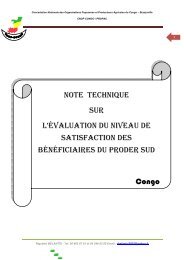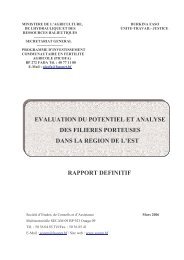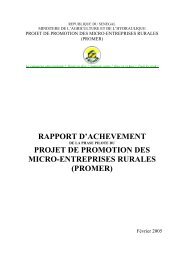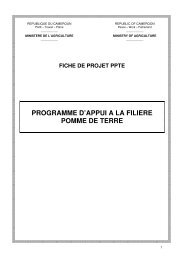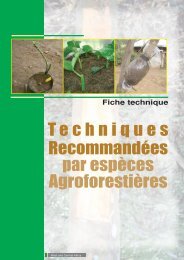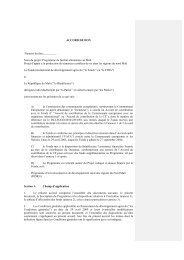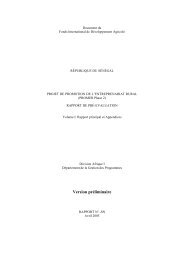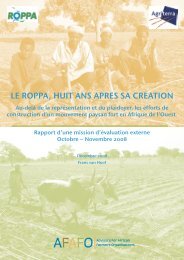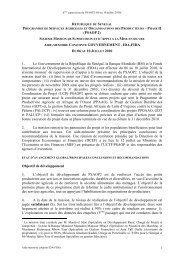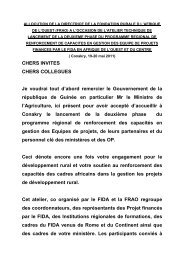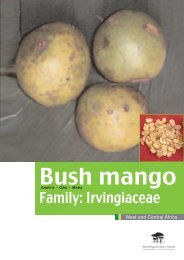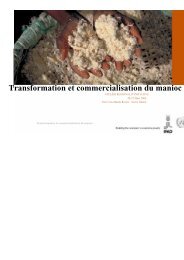Scaling Up the Fight Against Rural Poverty - FIDAfrique
Scaling Up the Fight Against Rural Poverty - FIDAfrique
Scaling Up the Fight Against Rural Poverty - FIDAfrique
You also want an ePaper? Increase the reach of your titles
YUMPU automatically turns print PDFs into web optimized ePapers that Google loves.
<strong>the</strong> 2000s, about a quarter of <strong>the</strong> population lives in poverty today. But <strong>the</strong> poverty incidence is<br />
shallow and widely dispersed across <strong>the</strong> country. As a result, narrowly targeted anti-poverty programs,<br />
whe<strong>the</strong>r by geography or by population stratum, cannot be readily implemented (in contrast to Peru).<br />
This has had significant implications for <strong>the</strong> design of IFAD’s program. Since 1999, IFAD approved<br />
four projects, of which one has been completed. A fifth project is currently under preparation. The<br />
total loan amount committed to date is $48.6 million. (See Box 3)<br />
Box 3. Changing design features in IFAD’s Moldova country program<br />
• IFAD Project I aimed to streng<strong>the</strong>n <strong>the</strong> microfinance system through support to <strong>the</strong> Savings and<br />
Credits Associations (SCAs). It also channelled medium-and long-term credit through commercial<br />
banks for investment lending for agricultural production.<br />
• IFAD Project II focused on participatory community development. Development plans were to be<br />
prepared by rural communities and private investments supported by IFAD funded bank credits<br />
were to be directed to support <strong>the</strong>se plans. At <strong>the</strong> request of <strong>the</strong> government no microfinance<br />
support was included.<br />
• IFAD Project III strongly promoted credits to commercial banks for on-lending to small and<br />
medium sized rural enterprises, since <strong>the</strong> community development approach under IFAD II failed.<br />
One third of loans extended were larger than US$ 100,000. The program disbursed rapidly.<br />
• IFAD Project IV principally supports <strong>the</strong> development of <strong>the</strong> horticulture value chain development<br />
through training, technical assistance and credit support.<br />
• IFAD Project V is currently under preparation and promises a wide range of old and new features:<br />
support for <strong>the</strong> development of agro business and multiple value chains, for microfinance through<br />
multiple channels, and for young entrepreneurs.<br />
• All projects involves NGOs as service providers to help rural entrepreneurs to identify business<br />
opportunities and to help prepare business plans that <strong>the</strong>n can be submitted to commercial banks<br />
for financing.<br />
• IFAD Projects III and IV also support a grant scheme for public infrastructure development. There<br />
is much demand for <strong>the</strong>se grants and implementation is judged to be very successful.<br />
Source: Arntraud Hartmann, based on IFAD project documents<br />
a) <strong>Scaling</strong>-up pathways – reaching substantial scale in financial intermediation<br />
IFAD has developed into a very substantial provider of medium and long-term credit for rural<br />
enterprises in Moldova. This scale was achieved through four successive projects, even though only<br />
one of <strong>the</strong>se projects had provision of investment credit as its main focus. The design of o<strong>the</strong>r projects<br />
focused on different priorities, such as support for microcredit lending, for community development,<br />
for rural SMEs, for value chain development, and for rural infrastructure development. Whatever <strong>the</strong><br />
project design, investment lending through banks to a broad base of rural producers always emerged<br />
and remained as <strong>the</strong> mainstay activity throughout. As a result of this sustained engagement IFAD has<br />
emerged as a major provider of rural investment credit.<br />
Due to changing project priorities a systematic pathway for scaling up in o<strong>the</strong>r IFAD supported<br />
activities is not evident in project documentation. Some of <strong>the</strong> design shifts were responses to<br />
changing government priorities: e.g., <strong>the</strong> scaling up pathway for microcredit programs was interrupted<br />
for several years due to lack of interest by <strong>the</strong> government. O<strong>the</strong>r changes resulted from<br />
implementation experience: e.g., <strong>the</strong> community-based investment planning approach was not<br />
considered successful. O<strong>the</strong>r changes were introduced to attempt a better targeting on <strong>the</strong> rural poor.<br />
The value chain approach was introduced to help target investment lending to activities that are labor<br />
intensive. O<strong>the</strong>r programs, such as <strong>the</strong> rural infrastructure program, are do not have a prolonged record<br />
19



